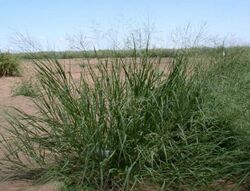Biology:Panicum coloratum
| Panicum coloratum | |
|---|---|

| |
| Scientific classification | |
| Kingdom: | Plantae |
| Clade: | Tracheophytes |
| Clade: | Angiosperms |
| Clade: | Monocots |
| Clade: | Commelinids |
| Order: | Poales |
| Family: | Poaceae |
| Subfamily: | Panicoideae |
| Genus: | Panicum |
| Species: | P. coloratum
|
| Binomial name | |
| Panicum coloratum | |
Panicum coloratum is a species of grass known by the common names kleingrass, blue panicgrass[1] (USA),[2][3] white buffalograss (southern Africa);[1] Bambatsi panic, makarikari grass,[2] and coolah grass (Australia).[1] It is native to Africa,[3] and it has been introduced elsewhere, such as the United States and Australia, and bred into many cultivars.[1]
This plant is variable in appearance.[1] In general, is a perennial bunchgrass which usually has rhizomes. The firm, mostly upright stems grow up to 1.4 m (4.6 ft) tall. The leaf blades are 10 to 30 cm (3.9 to 11.8 in) long.[4] They are green to a waxy blue-green color.[1] The panicles are variable in length.[4] The spikelets are green and purple.[1]
This grass is used as a pasture grass and to make hay.[1] It produces a large amount of forage for animals.[3] It is drought-tolerant and does well in hot climates.[5] This C4 plant can grow on saline soils[6] and requires some of sodium for effective photosynthesis.[7][8] Different cultivars have varying tolerances of sodium.[9] While it makes a good graze for most animals, the grass has occasionally been associated with liver damage and photosensitivity in young ruminants and horses.[3][10][11] This photosensitivity can lead to sunburn, which causes swelling of the head and ears of the animal, a condition commonly called "swellhead".[12]
Cultivars include 'Pollock', 'Bambatsi',[2] 'Bushman Mine', 'Verde',[1] and 'Kabulabula'.[8]
References
- ↑ Jump up to: 1.0 1.1 1.2 1.3 1.4 1.5 1.6 1.7 1.8 Panicum coloratum. Tropical Forages.
- ↑ Jump up to: 2.0 2.1 2.2 Bambatsi Panic. Government of Western Australia Department of Agriculture and Food.
- ↑ Jump up to: 3.0 3.1 3.2 3.3 Panicum coloratum. USDA NRCS Plant Fact Sheet.
- ↑ Jump up to: 4.0 4.1 Panicum coloratum. Grass Manual Treatment.
- ↑ Blake, C. Kleingrass gains ground in desert ag. Western Farm Press September 3, 2009.
- ↑ Behling, A. Kleingrass catches on. Hay and Forage Grower February 1, 2001.
- ↑ Murata, S. and J. Sekiya. (1992). Effects of sodium on photosynthesis in Panicum coloratum. Plant Cell Physiol 33(8) 1239-42.
- ↑ Jump up to: 8.0 8.1 Matoh, Tōru; Murata, Shinji (1 April 1990). "Sodium Stimulates Growth of Panicum coloratum through Enhanced Photosynthesis". Plant Physiology 92 (4): 1169–1173. doi:10.1104/pp.92.4.1169. PMID 16667386.
- ↑ Seffino, L. García (September 1998). "Salinity effects on the early development stages of Panicum coloratum : cultivar differences". Grass and Forage Science 53 (3): 270–278. doi:10.1046/j.1365-2494.1998.00139.x.
- ↑ Hepatotoxic Plants. Merck Veterinary Manual.
- ↑ Bridges, C. H.; Camp, B. J.; Livingston, C. W.; Bailey, E. M. (November 1987). "Kleingrass ( Panicum coloratum L.) Poisoning in Sheep". Veterinary Pathology 24 (6): 525–531. doi:10.1177/030098588702400609. PMID 3455080.
- ↑ Sheep, goat producers should watch for kleingrass problems. Livestock Weekly
External links
- USDA Plants Profile
- Cornick, JL; Carter, GK; Bridges, CH (15 October 1988). "Kleingrass-associated hepatotoxicosis in horses". Journal of the American Veterinary Medical Association 193 (8): 932–5. PMID 3192474.
Wikidata ☰ Q7131126 entry
 |

